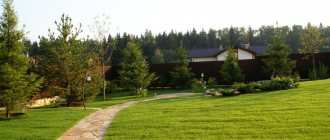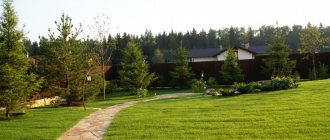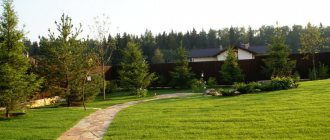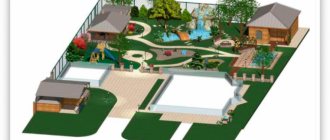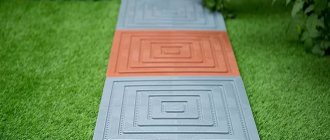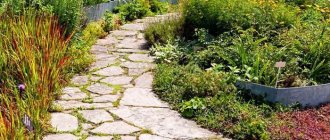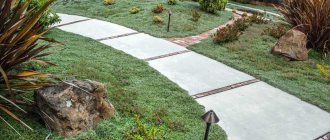Gravel path
This is a budget option for designing a country path. Thanks to its structure, gravel will perfectly allow water to pass through empty areas, which will allow you to walk comfortably in rain and mud.
This material will help you easily give the desired shape for the garden path, which can always be changed or supplemented. This is a simple, effective and mobile option for landscaping.
One of the disadvantages is that gravel perfectly allows weeds and grass to pass through. And it will have to be cleaned periodically. Like any number of small elements, gravel is difficult to keep in one position. And to maintain the integrity of the design, it is better to use borders for garden paths.
Using lawn to create a path
What are the nuances when making garden paths from lawn? To maintain an attractive appearance, the lawn requires constant care. Watering, weeding and cutting.
It is also important to have constant natural light. With constant use, it quickly gets trampled, bald spots appear and the overall appearance deteriorates.
One of the advantages is that with proper care, the path looks very beautiful and creates a feeling of comfort and well-groomed. In addition, it is pleasant to walk on it.
There is an interesting life hack for caring for such a path. To make lawn maintenance easier, choose a width that matches the width of your lawn mower. This will save time significantly.
Tile path
Paving slabs add a sense of elegance to the space. The main feature is the minimum requirements for care and maintenance. With high-quality installation, tiles will serve you for many decades. And keep a well-groomed appearance.
But there are also disadvantages to this style. First of all is the price. This type of design is considered the most expensive. Even DIY installation will not help reduce costs.
Some tips for laying paving slabs yourself:
- To add more rigor to the design, use a garden border.
- The tiles must be laid when it has not rained and will not rain for at least a week. This is the most important condition. It is its compliance that determines the service life of the track.
- If you live in an area with heavy and prolonged rain, you should consider drainage for the path.
How to make a beautiful and durable path at your dacha yourself
For those who want to relax a little and read a humorous impromptu story, it seems... Dear readers, unfortunately, there was no answer to my question from the author of the comment above, so there are big doubts whether the path he proposed was made at all, or how it is said, “I heard a ringing...”, because. registration and a single comment, as a rule, in most cases mean regular spam, it is unclear why it was written. So, over the weekend I made a simple mathematical calculation of what the author of the comment above suggested you do to make the track. And the result suggests that it is he who offers you how not to make a path in your dacha. Next, the calculation was made for a path with my parameters: 80cm width and 42m length. And, since I love writing stories, we’ll add a little color here too for a more interesting reading.
1. So, you are offered at the dacha (at the dacha, and not around the lunar module of the astronauts on the Moon and not on the approach to the Egyptian pyramids) to make a path to make a soil sample of MINIMUM 50 cm. Since it is written MINIMUM 50 cm, then we will take the next 60 for calculations cm, mind you, not even 70. Further, it is assumed that an ordinary summer resident, whether it’s me or a pensioner, takes a shovel and brings out the volume of soil, just think about it! - 0.8m width x 0.6m depth x 42m length = 20.16 cubic meters. Chernozem weighs approximately 1.45 tons/cubic meter, and loam, which often starts at 30-40cm deep, weighs 2.71 tons/cubic meter, so to simplify things we average it out and take the value 2 tons/cubic meter. Those. To make a path, you are offered to dig a ditch and throw soil weighing 40 tons onto the surface (the same weight as a lightweight tank). I can already imagine this process in reality. Together, all the summer residents on the massif are digging ditches.
2. For example, you are a fan of digging deep trenches and yet decided to hire a team of diggers who are not involved in charity and will charge you 25-30 thousand rubles for the work, since they are ready to dig a hole for the foundation of a house in a dacha area for 10-15 thousand, and for a house, for example, measuring 6x6m, the volume will be 2 times smaller. You think and begin to doubt, but don’t worry, because there is a way out - see point 3...
3. If you get along with animals, then you can save on diggers and try to tame and train a small colony of good-natured moles. With a diameter of the average mole of 7 cm, its cross-sectional area will be 3.14 x 0.035 x 0.035 = 0.00385 square meters. m. And the cross-sectional area of the ditch that you need to dig is 0.6 x 0.8 = 0.48 square meters. m. Thus, you need to tame a flock of moles in the amount of 0.48/0.00385 = 125 individuals. After they dig a ditch for you, for humane reasons, you can give them treats in bundles and send them home.
4. Now you need somewhere to put this volume of soil 20 m3, and for ease of perception, imagine it is a pillar 2 m by 2 m in length and width and 5 m in height. And all this earth lies on both sides of the ditch, covering everything that is possible. Of the 8 acres of the dacha, you are unlikely to find so much space for backfilling, because you will not fill up strawberries, trees and other plantings, around the house and bathhouse, otherwise the blind area will be below ground level. There remains about 1-1.5 acres for a vegetable garden. Plus, clay and loam will still have to be removed. The solution is to take all the soil outside the fence and put it in a huge, neat pyramid, five meters high, with base sides measuring 2 by 4 meters. In winter, you can pour water on top of the fallen snow and make an ice cube for the kids.
5.
6. But that’s not all, the worst is yet to come. After all, now you have to fill the ditch with small, expensive crushed stone, namely the same 20 cubic meters. I open the Internet and look - 1 m3 of crushed gravel, fraction 5x20, costs 2360 rubles. If you order 20 m3 at once, we get a discount and cost 36,000 rubles. True, it is not clear whether delivery is included there, because dachas can be very far away. And all this is only for the cushion under the path, since there is also a working part of the path, which should rise above the ground. And there are curbs, and a cement-sand mixture, and tiles... So, a KamAZ with a carrying capacity of 15 tons is capable of bringing you on average about 10 tons of crushed stone due to the limitation of the volume of the body, which means that the summer resident is invited to buy and pour 2 of these Kamaz small crushed stones into an earthen ditch . 2 Kamaz. For the path. In the country. After all, the article is about making a path in the country. But what the comment in question was about is unclear. Crushed gravel weighs 1.35 tons/cubic meter. That is, now you have to throw 27 tons of crushed stone into the ditch. Well, or demolish the fence and pour it there directly from the trucks, which will break all your buildings and plantings. But the option is already imagining how the summer residents lined up and are already calling, ordering 2 Kamaz trucks of crushed stone to compact it into the ground for the path.
6. By the way, it will be very convenient to throw the 40 tons of soil extracted from the ditch into these same Kamaz trucks with shovels (they will throw them in a couple of days), so in two trips they will transport the unnecessary soil to places where soil is freely accepted. This is another 20 thousand for diggers and 10 thousand for drivers; moles won’t help here.
7. I think that's enough. Eh, I still had to write a full-fledged story with drawings, on a scale that took into account all proportions. Anyway.
8. Well, and point eight. It’s a pity to waste time on such calculations, and, unfortunately, you can’t put a “spam” emoticon on a comment. Therefore, in the future, I will leave comments of this order unanswered. I write about personal experience and about the real implementation of something in life, and not about “how to do it and how not to do it.” The point here is not at all about the track. Naturally, different people like different cars, different houses, bathhouses, paths, and this is wonderful, because... there is plenty to choose from. And every person has the right to self-expression in comments, it’s just a pity that often, apart from misleading readers, they contain little that is close to reality. Although, perhaps there was an error and the comment went in the wrong place, but in fact it was really intended to discuss the construction of the lunar module... Good luck and prosperity to everyone.
river stone
The simplest river stone can turn a path into a work of art. By selecting a sufficient number of light, gray and dark stones of similar shade, you can lay out any picture or ornament. This is long and painstaking work. But the resulting design will be absolutely unique. And you can be proud of yourself, listen to rave reviews from friends and family.
First of all, it is necessary to sort the stones by color, and also get rid of defective stones and stones with obvious flaws. To facilitate further work, you can sort the stones by size.
It is important to create a feasible sketch of the future path. You can use ready-made ideas from the Internet or come up with your own design. It's easiest to style curls or squares.
The best manufacturers
We offer a brief description of the largest and most popular manufacturers of ceramic tiles in Russia.
Keramin
European manufacturing company. It has the largest sales volumes in the ceramics market. Specializes in the production of ceramic bricks, granite, tiles, sanitary ceramics. All Keramin products have registered certificates of conformity, and sanitary ceramics have a certificate of hygienic registration, environmental ISO 14001-2005.
Photo: Keramin tiles
Finished products undergo constant quality control. New equipment has been installed in the workshops, thereby reducing the duration of the technological process and increasing production volumes.
Kerama Marazzi
Domestic manufacturing plant with a wide network of distribution companies. Founded in 1988 in the city of Orel.
Kerama Marazzi produces ceramic tiles and granite, borders, steps, panels, mosaics and other elements. The company's catalog contains over 2000 items.
The quality of products is confirmed by compliance with international, state standards and requirements, and expert opinions. The Marazzi factory also produces many thematic collections of ceramics. Applications for individual orders are accepted.
Stone Age
Russian manufacturing plant. It has been producing paving slabs for more than 12 years. In 2012, the entire production line was re-equipped to European standards. The ColorMix system was introduced to make an analogue of imported clinker. Models of floor slabs with granite, quartz, and basalt chips have been added.
Gothic
Domestic tile manufacturer. The factory was founded in 2005. “Gothic” products are often called mosplite, since many iconic places in Moscow are paved with it (Alexandrovsky Garden, Old Arbat). German HESS equipment is installed in the workshops. The tiles are created using the semi-dry vibration pressing method. Manufactured products are divided into PREMIUM and PROFI classes. The first has a high cost and imitates natural stone in appearance, the second is standard sidewalk tiles in different colors.
Path using tree bark
Bark is a cheap material that can be purchased at any hardware store. An interesting feature of the bark is that it prevents weeds from growing. Accordingly, such a path will require a minimum of care and time.
Flaws:
- it is necessary to add bark to the path every season;
- Some of the material is carried by the wind or on the soles of shoes, which also affects the need to add bark to some areas.
Video description
About LED paving stones in the following video:
Combined styling Source yandex.ru
- Guarantee . Allows for replacement if part of the material differs in color or quality.
- Price . Before purchasing, it would be useful to familiarize yourself with the average prices for the products you are interested in. Sometimes, in order to reduce the price, the manufacturer saves on dye by adding it only to the front (top) layer. Paths with such a coating will quickly wear out and lose their attractiveness.
- Calculation of the required quantity . It is considered correct to purchase 5% more material than needed. This will allow you to maneuver in case of color discrepancies and have a reserve for repairs.
